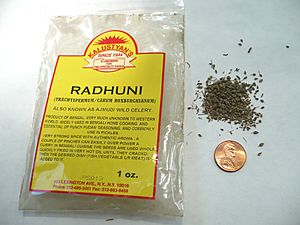Radhuni facts for kids
Quick facts for kids Radhuni |
|
|---|---|
 |
|
| Radhuni seeds | |
| Scientific classification | |
| Genus: |
Trachyspermum
|
| Species: |
roxburghianum
|
| Synonyms | |
|
|
Trachyspermum roxburghianum is a special flowering plant. It is also known as Carum roxburghianum or Radhuni. This plant belongs to the Apiaceae family, which includes plants like carrots and parsley. People grow it a lot in places like South Asia, Southeast Asia, and Indonesia.
Its tiny, dried fruits look a bit like seeds. They have a strong smell and taste. In Bengali cuisine, which is popular in Bangladesh and parts of India, these "seeds" are used often. They are not used as much in other parts of India. In Thailand, people use the fresh leaves as an herb. It is also used in traditional medicine in Myanmar and Sri Lanka.
What Radhuni Looks Like
The small, dried fruits of the Radhuni plant are often called "seeds." They look a lot like the seeds from other plants such as ajwain, celery, and caraway. Because they look and taste similar, Radhuni is sometimes confused with celery seed.
Names for Radhuni
The plant has different names in different languages. In Bengali, it is called radhuni (Bengali: রাধুনি). Some people call it "wild celery" in English.
In Hindi and Urdu, it is known as ajmod (Hindi: अजमोद) or (Urdu: اجمود). These names come from old Sanskrit words like ajamoda (Sanskrit: अजमोद) or ajamodika (Sanskrit: अजमोदिका). The name for ajwain also comes from these Sanskrit words.
In Myanmar, it is called kant-balu. In Thai, it is known as phak chi lom (Thai: ผักชีล้อม). However, this Thai name can also mean a type of celery. In Sri Lanka, it is called asamodagam (අසමෝදගම්).
How Radhuni is Used
Radhuni is a very strong spice. It smells a bit like parsley and tastes similar to celery. Just a small amount can add a lot of flavor to a dish.
In Bengali cuisine, the whole "seeds" are used. Cooks often fry them quickly in very hot oil until they make a crackling sound. Radhuni is a common ingredient in a Bengali dish called Shukto.
Sometimes, Radhuni is part of a special spice mix called panch phoron (Bengali five spice). In this mix, Radhuni might replace black mustard seeds. The other spices in panch phoron are cumin seed, fenugreek seed, fennel seed, and Nigella Seed.
In other places, Radhuni is used in pickling or in different spice mixtures. People also use it in traditional medicine. It is sometimes used for problems like upset stomachs, loss of appetite, or indigestion.

